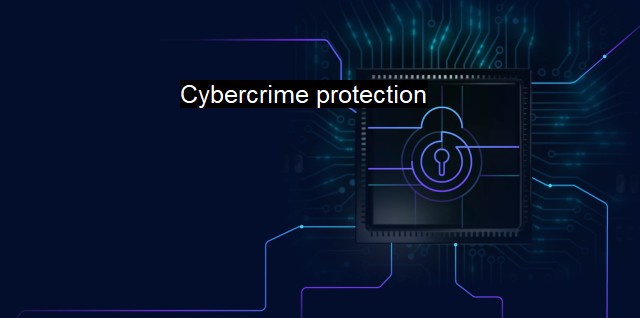What is Cybercrime protection?
Cybercrime Protection: Strategies and Tools to Safeguard Against Evolving Threats in the Digital Age
Cybercrime protection is a fundamental element of the digital world, falling under the umbrella of cybersecurity. It primarily revolves around techniques, strategies, and solutions devised to protect internet-based systems from digital attacks. Cybercrime protection embodies a holistic approach, striving to comprehensively ward off potential threats and provide instant defense to safeguard personal, professional, business, or governmental data from breaches and cyberattacks.To begin with, it is vital to comprehend the nature and breadth of cybercrimes to completely grasp cybercrime protection's importance. Cybercrimes often include but are not restricted to stealing identities, violating privacy, stealing business/organizational secrets, hacking systems, distributing child pornography, and phishing scams. These crimes can tremendously disrupt, damage, or create chaos in personal, corporate, or national security spheres by maliciously exploiting various systems and networks.
Hence, Cybercrime protection emerges as drastically crucial in warding off these threats. Offering manifold benefits such as financial protection, data security, protection from reputational damage, safeguarding productivity, and compliance with regulatory obligations, it is not just advised but indispensable for corporations, governments, and individuals.
Meanwhile, Cybercrime protection strategies revolve around making digitally stored information unavailable for illegitimate usage. Implementing robust, reliable, and complex authentication requirements, running regular software updates, backing data up, performing regular security audits, ensuring sensitive data encryption, and creating secure networks through firewalls are standard, proactive strategic moves.
Modern means of protection extend to establishing secure cloud storage solutions, using VPNs for secure connections, implementing multi-factor authentication, and continually adapting to stay ahead of evolving cyber threats. User education forms an integral part of cybercrime protection as well, involving the spreading of good practices among users, such as not opening suspicious mails, not downloading from untrusted sources, using strong passwords, and keeping systems updated.
A key player in cybercrime protection is antivirus software. Antivirus applications recognize, warn, and eliminate threats before they can exploit system vulnerabilities. These include malware attacks, Trojans, worms, viruses that can exploit security weaknesses. Antivirus software incessantly updates their databases with definitions of new potential threats. This process, named heuristics, uses previously gathered information to predetermine attributes that a file might possess if it were harmful, thereby stopping many threats before they can cause issues.
Many antivirus software also offers 'real-time' protection, scanning files before they are opened or downloaded to preemptively fend off any potential problems. They can create automated routines that will scan your system in the background, preventing active malicious software after detecting it. They can alert the user of emails and websites known for phishing attacks and even provide password management.
Cybersecurity protocol announced by a globe national System and Communications Reliability division urges workplaces to implement a cybersecurity policy, limit employee access to sensitive information, and set terms on password usage and internet guidelines among other steps.
Despite all its advantages, cybercrime protection is not foolproof. Cybercriminals constantly develop new strategies, making it a perpetual tustle to remain a step ahead of them. Hence, it is of absolute importance to understand that while Cybercrime protection is critical, it is equally important to practice good 'digital hygiene' to limit damage even if a breach occurs.
To sum up, cybercrime protection is robust, evolving, and intrinsic in today's digital world due to the omnipresence of sensitive information and systems reliant on secure networks. Its strategies, implementation, and impact differ, making it a highly contextual issue. Therefore, with the escalating reliance on digital channels, cybercrime protection-dependent robust cybersecurity and up-to-date antivirus measures have never been more crucial. Everyone, from major multi-national corporations to everyday computer users, must understand and utilize cybercrime protection techniques.

Cybercrime protection FAQs
What is cybercrime protection?
Cybercrime protection refers to a set of measures individuals and organizations take to protect their digital assets from cyber-attacks, such as malware, viruses, phishing, and other malicious activities.What are some common cybercrime protection measures?
Some common cybercrime protection measures include installing and updating antivirus software, using strong and unique passwords, enabling two-factor authentication, avoiding suspicious emails and links, using a virtual private network (VPN), and regularly backing up data.Why is cybercrime protection important?
Cybercrime protection is important because cybercriminals are constantly innovating new ways to steal sensitive data such as login credentials, financial information, and personal identification details. A successful cyber-attack can result in severe consequences, including financial loss, reputational damage, and legal repercussions.What are the consequences of not having cybercrime protection?
Not having cybercrime protection can lead to severe consequences, including data breaches, identity theft, and financial loss. Cybercriminals can access and steal personal and sensitive data, which can be sold on the dark web or used for fraudulent activities. This can lead to significant financial loss, reputational damage, and legal repercussions for individuals and organizations.| | A | | | B | | | C | | | D | | | E | | | F | | | G | | | H | | | I | | | J | | | K | | | L | | | M | |
| | N | | | O | | | P | | | Q | | | R | | | S | | | T | | | U | | | V | | | W | | | X | | | Y | | | Z | |
| | 1 | | | 2 | | | 3 | | | 4 | | | 7 | | | 8 | | |||||||